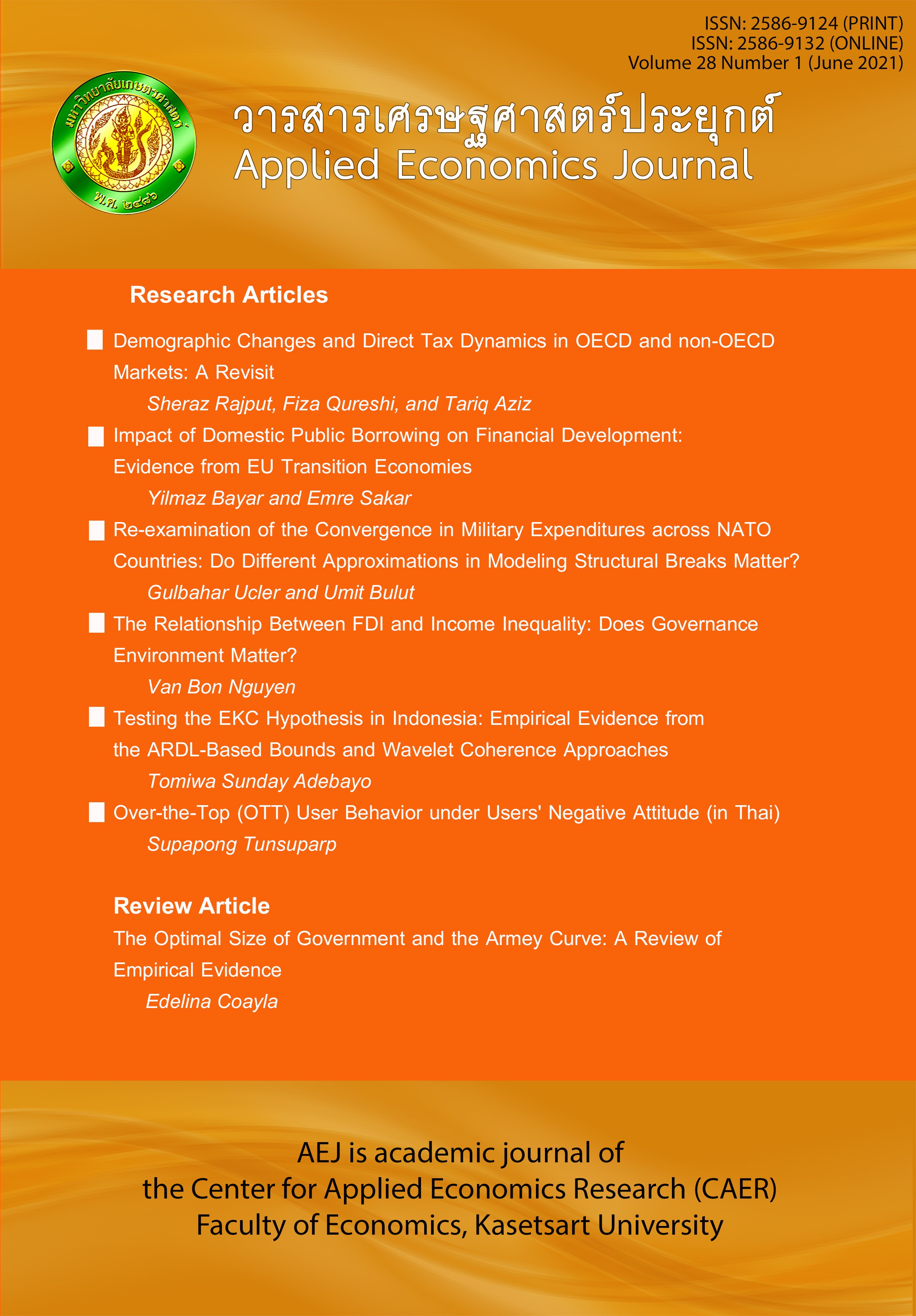Re-examination of the Convergence in Military Expenditures across NATO Countries: Do Different Approximations in Modelling Structural Breaks Matter?
Main Article Content
Abstract
The goal of this paper is to examine whether the ratio of military expenditures to GDP converges across 27 NATO countries for the period 1993-2018 within the scope of the stochastic convergence analysis. For this purpose, by paying regard to modelling structural breaks, the paper employs unit root tests with and without sharp breaks and also a unit root test with gradual breaks. The empirical findings imply that using different approximations in modelling structural breaks result in different output. The findings indicate weak evidence for the presence of the convergence as well. Theoretical and practical implications of these findings are discussed.
Article Details
The paper is published under CC BY-NC-ND, in which the article is freely downloaded and shared in its original form non-commercially and its citation details are identified.
References
Acemoglu, D. (2009). Introduction to modern economic growth. Princeton: Princeton University Press.
Apergis, N., Christou, C., & Hassapis, C. (2013). Convergence in public expenditures across EU countries: Evidence from club convergence. Economics & Finance Research, 1(1), 45–59.
Arvanitidis, P., & Kollias, C. (2018). Global patterns of convergence and divergence in defence burdens: 1950–2015. A bird’s eye view (CESPIC Working Paper No.2018/03). Tirana: European Centre of Peace Science, Integration and Cooperation.
Arvanitidis, P., Kollias, C., & Anastasopoulos, K. (2014). Is there an international convergence in defence burdens? Some initial findings. Peace Economics, Peace Science and Public Policy, 20(4), 611–620.
Bagbaslioglu, A. (2016). A new solution seeking for a timeless issue burden sharing: Smart defense and NATO (in Turkish). Gazi Akademik Bakıs, 10(19), 209–209.
Barro, R. J., & Sala-i-Martin, X. (1991). Convergence across states and regions. Brookings Papers on Economic Activity, (1991)1, 107–182.
Barro, R. J., & Sala-i-Martin, X. (1992). Convergence. Journal of Political Economy, 100(2), 223–251.
Barro, R. J., & Sala-i-Martin, X. (2004). Economic growth (2nd ed.). Cambridge, MA: MIT Press.
Bernard, A. B., & Durlauf, S. N. (1995). Convergence in international output. Journal of Applied Econometrics, 10(2), 97–108.
Binder, M., & Pesaran, M. H. (1999). Stochastic growth models and their econometric implications. Journal of Economic Growth, 4(2), 139–183.
Carlino, G. A., & Mills, L. O. (1993). Are U.S. regional incomes converging? A time series analysis. Journal of Monetary Economics, 32(2), 335–346.
Clements, B. J., Gupta, S., & Khamidova, S. (2019). Is military spending converging across countries? An examination of trends and key determinants (IMF Working Paper No. 19/196). Washington, DC: International Monetary Fund.
Das, R. C., Dinda, S., & Martin, F. (2018). Defence outlays across countries: Are they converging? South Asian Journal of Macroeconomics and Public Finance, 7(1), 109–129.
Dickey, D. A., & Fuller, W. A. (1981). Likelihood ratio statistics for autoregressive time series with a unit root. Econometrica, 49(4), 1057–1072.
Durusu-Ciftci, D., & Nazlioglu, S. (2019). Does income converge in Turkey? An empirical assessment. Ege Akademik Bakis (Ege Academic Review), 19(1), 15-32.
Enders, W., & Lee, J. (2012). The flexible Fourier form and Dickey-Fuller type unit root tests. Economics Letters, 117(1), 196–199.
Guris, S., Guris, B., & Tirasoglu, M. (2017). Do military expenditures converge in NATO countries? Linear and nonlinear unit root test evidence. Theoretical and Applied Economics, 24(2), 237–248.
Lau, C. K. M., Demir, E., & Bilgin, M. H. (2016). A nonlinear model of military expenditure convergence: Evidence from estar nonlinear unit root test. Defence and Peace Economics, 27(3), 392–403.
Mankiw, N. G., Romer, D., & Weil, D. N. (1992). A contribution to the empirics of economic growth. Quarterly Journal of Economics, 107(2), 407–437.
Mesterhazy, A. (2018). Burden sharing: New commitments in a new era. Retrieved from https://www.nato-pa.int/download-file?filename=sites/default/files/2018-12/2018%20-%20BURDEN%20SHARING%20NEW%20COMMITMENTS%20IN%20A%20NEW%20ERA%20-%20MESTERHAZY%20REPORT%20-%20170%20DSCTC%2018%20E%20rev1%20fin.pdf.
Narayan, P. K., & Popp, S. (2010). A new unit root test with two structural breaks in level and slope at unknown time. Journal of Applied Statistics, 37(9), 1425–1438.
NATO (2019). Defense expenditure of NATO countries. Retrieved from https://www.nato.int/cps/en/natohq/news_167080.htm.
Perron, P. (1989). The great crash, the oil price shock, and the unit root hypothesis. Econometrica, 57(6), 1361–1401.
Pesaran, M. H. (2007). A pair-wise approach to testing for output and growth convergence. Journal of Econometrics, 138(1), 312–355.
Quah, D. (1993). Galton’s fallacy and tests of the convergence hypothesis. Scandinavian Journal of Economics, 95(4), 427–443.
Quah, D. (1996). Empirics for economic growth and convergence. European Economic Review, 40(1), 1353–1375.
Sala-i-Martin, X. X. (1996). The classical approach to convergence analysis. Economic Journal, 106(437), 1019–1036.
SIPRI. (2019). SIPRI databases. Retrieved from https://sipri.org/databases.
Yazgan, S., Ceylan, R., & Mollavelioglu, M. S. (2018). Military expenditure convergence in the selected NATO countries: Evidence from non-linear unit root tests (in Turkish). Akdeniz IIBF Journal, 37, 118–132.
Young, A. T., Higgins, M. J., & Levy, D. (2008). Sigma convergence versus beta convergence: Evidence from U.S. county-level data. Journal of Money, Credit and Banking, 40(5), 1083–1093.
Zivot, E., & Andrews, D. W. K. (1992). Further evidence on the great crash, the oil-price shock, and the unit-root hypothesis. Journal of Business and Economic Statistics, 10(3), 251–270.


